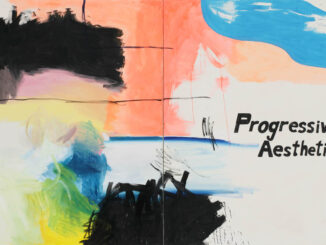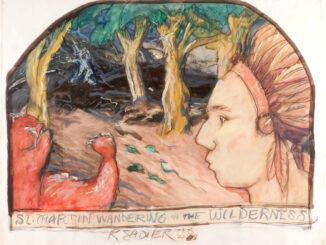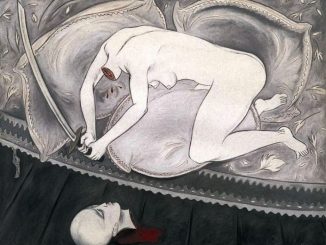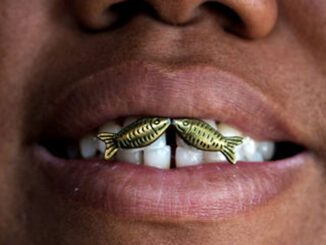A Solo Show by Rosario Bond.
From Jun 25 through Sept 10, 2011.
 In her new series Diary of A Shopaholic (2011), Rosario Bond reveals a new creative chapter devoted to unsettling beings and imaginary narratives. Light and gravity dominate over the flux of unorthodox elements she uses in her mixed media works.
In her new series Diary of A Shopaholic (2011), Rosario Bond reveals a new creative chapter devoted to unsettling beings and imaginary narratives. Light and gravity dominate over the flux of unorthodox elements she uses in her mixed media works.
On one side, there is a fresh and deliriously mixed compound of collated teen images, along with pasted-on-the-surface fashion robes, semi-precious stones, luxury fabrics, pearl earrings and necklaces, embodying ethos and lightness as a fruitful enjoying of life and its fashionable delights. Without hesitation, Bond points to the radiance and the sparkle of life. On the other side and on the same surface, one encounters a gallery of drawn and dripping feminine characters outlined in highly intense colors, distorted entities that have lost their shape and their allure. These disconcerted figures, accompanied by curling lines and twisted designs, bring out drama and chaos. With this, Bond proposes the divergent views that dominate women’s lives.
Beauty: The Feminine Mystique
At first, a pleasurable world of delirious paraphernalia emerges in Bond’s work depicting glamour, trends, and what is en vogue within a blissful, feminine universe. Soon, disquiet tensions of dystopian concepts appear within the proliferation of feminine objects and artifacts. It is beauty as coercion, the perfect body as the ultimate goal, and high-end fashion as a social parameter that are the disturbing concepts in a society of luscious bodies and pageantry. Bond’s works reflect social and ideological allusions towards the feminine condition, and are created through an innocent and apparently gleaming surface. Twiggy, Barbie, or Charlie’s Angels act as updated feminine stereotypes that serve as utopian references to Bond’s profiled women. A sort of a ‘feminine mystique’ in the form of a beauty queen comes into sight when we review her works. Fashion models cut out from magazines, high-end costume jewelry, designer shoes, perfumes, and cosmetics, conform to the tumultuous arrangement of articles in which the feminine myths materialize beauty as an asset, and depict beauty as a market, and give it a consumption value. But amidst all the emphasis of being “beautiful and perfect “, there is a ludicrous task, a foolish and comical gesture, and an outrageous reality. Beauty is indeed a socially created burden and an illusionistic failed intent hardly and temporarily attained. Beauty disappears with age and life changes. Beauty is a utopian idea that constricts women’s lives, but even while knowing the trappings and trickery of this utopian mockery, women pursue it as their basic survival mode. Beauty is power and status. Bond’s work reflects on these feminine predicaments with irony and parody.
The Kitsch – The Camp
In their provocative imagery, imperfect textures within intermixed paints, resins, and plastics, and the profuse intricacy of feminine simulacra, Bond’s works create a lively magnetism and charisma that interconnect with pop culture. Her appropriation of kitsch is challenging. Her way of playing with the raw, the unorthodox, and the clichéd, produce a work of an anti-aesthetic stanza. For a naive viewer the works could easily fall into the most pure, tasteless art, a tacky art. At a closer look, banal and prosaic images act as points of departure for metaphors and metonyms as injunctions and commanding directives. Encompassing humor, fun and satire, Bond re-creates an operatic theater of women’s order in our times. Through a make-up operation, the artist disguises a political discourse on these feminine demons. With her own campy style, the artist stereotypes figures and contexts, undermining their false preconceptions on consumerism and oppression. The trivial and the superficial are only the form of a profound content. Bond offers a bound criticism and a sharp political perspective in her works of painting, installations and sculptures.
All About Me: A Self Portrait
Artists usually transfer their concerns, life experiences, and visual memories into their work, crystallizing their own stories but also reflecting their era and their social context. With All About Me, Rosario Bond proposes a myriad of visual portraits that also function as self-portraits. The woman’s condition is also her own condition substantiated by the different critical notions on femininity she chooses to depict within her work. Each work mirrors her feminine universe. Every constraint, every boundary, every limit present in women is also present in her world as a woman. Bond’s works serves as a self-reflection. In the tradition of the strong feminist art movement that emerged since the 60’s till present; the artist has aligned herself into the same predicament. Following the steps of millenary artists such as Lynda Benglis, Roni Horn, Janine Anthony, Betye Saar, Jenny Holzer, Judy Chicago, Kiki Smith, Lorna Simpson, Cindy Sherman, Nan Golding, and of more contemporary ones such as Shirin Neshat, Mimi Smith, Laurie Simmons, Tsuneko Taniuichi, Cecile Dahl, and many others, Bond actively makes a statement on the critical feminist approach, expanding the perceptions and status of contemporary women and evaluating the context and the political implications of women in society.
Curator’s Voice Art Projects
2509 NW Second Avenue
Miami, FL 33127
786.357.0568
www.curatorsvoiceartprojects.com







Be the first to comment